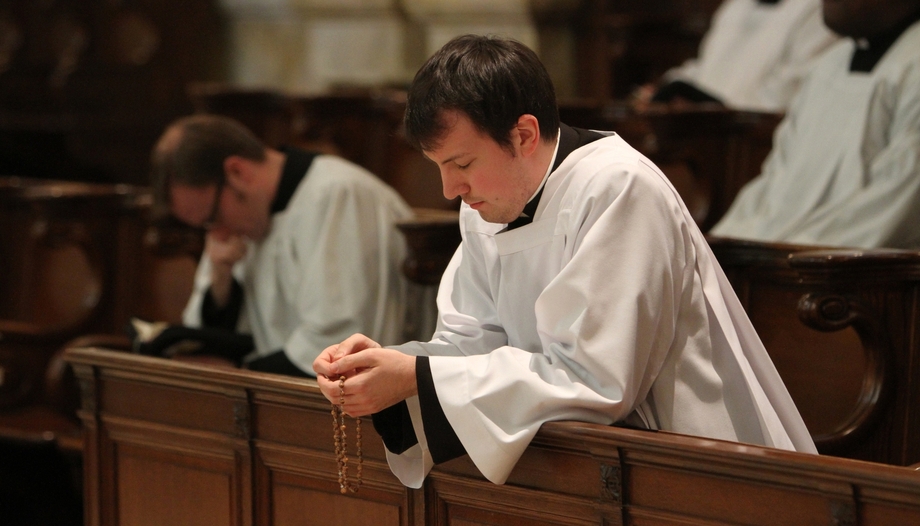 Carlos Chiclana: "Priests must take care of themselves in order to take care of others".
Carlos Chiclana: "Priests must take care of themselves in order to take care of others". Which Church, which priests?
Which Church, which priests?There are those who say that there are fewer and fewer priests, and they are right. However, there are still men who give their whole life to God. A study conducted by the U.S. Conference of Catholic Bishops shows that God continues to call men to leave everything and follow Him.
On the occasion of the World Day of Prayer for Vocations, the U.S. bishops' conference released these figures. The data comes from a survey conducted by CARA (Center for Applied Research in the Apostolate), which is part of Georgetown University.
The survey was sent to seminarians who are going to receive priestly ordination this year and of the 458 to whom it was sent, 334 responded. In this article we present some of the most significant information contained in the study.
Information and structure
The survey questions were varied. The respondents were asked to seminarists to provide answers about their education, discernment, previous work experience or the age at which they first considered the priesthood.
With the information obtained, the final document was divided into eight sections including graphs detailing the responses of the respondents.
Diocesan priests and religious
The seminarians who responded to the survey represent 116 U.S. dioceses and 24 different religious institutes. In all, 81 % of them will be ordained diocesan priests, while 19 % will be ordained within a religious order.
The dioceses or archdioceses with the largest number of seminarians are Arlington, Miami, Dallas and Cincinnati. In terms of congregations, most of the men to be ordained this year are from the Order of St. Benedict and the Order of Friars Minor Capuchin.
The relationship of seminarians with their diocese or with the congregation seems to be close, considering the data. On average, the next diocesan priests have lived in their diocese for 16 years. For their part, religious have known their brothers in the congregation for five years, on average.
In terms of where they studied, the two established groups came overwhelmingly from seminaries in the southern United States or the Midwest. The place where there have been fewer students has been the West, with only 13 % of the respondents. Not counting those who have prepared outside the country, which is 7 %.
Young priests
In general, the age at which seminarians first considered a priestly vocation is quite early. The responses put the average at 16 years of age (15 years in the case of diocesans, 17 in the congregations). Moreover, in general, religious began to consider becoming priests two years later than diocesan priests.
On the other hand, the average age of ordination is 33 years, so it can be concluded that these are young vocations.
Cultural curtain
Of the seminarians to be ordained, 64 % are Caucasian, Hispanics or Latinos make up 10 % and 6 % are black or African-American. The vast majority were born in the United States (75 %), demonstrating that it is a cradle of native vocations. The next most frequent countries of origin in the responses are Mexico, Vietnam, Nigeria and Colombia. In total, respondents come from 28 different nations.
In terms of educational model, only 11 % of the men were home schooled. In addition, the vast majority of seminarians have some college or undergraduate education. However, only 16 % obtained a college degree.
As for school, almost half of the respondents (43 %) studied in a Catholic elementary school, a figure that decreases at the high school (34 %) and college (35 %) stages.
Family roots
93 % of the seminarians received Baptism as a child and 7 % converted later, on average at age 22. It is also important to note that 84 % of respondents say that both their father and mother are Catholic. But only 33 % have a family member who is a priest or religious.
Parental unity is a significant finding. 92 % indicated that their parents were married and living together, while children of separated parents are only 4 %.
Religious practices
Of the males, 73 % said that they regularly attended Mass before entering the seminary and 66 % said that they prayed the Rosary. On the other hand, 72 % helped at Mass as an altar server and 52 % were also part of the parish youth group.
However, it is striking that the maximum number of participants in events such as FOCUS Seek Conference or World Youth Day only reaches 11 % in the most popular meeting, organized by Franciscan University.
Main influence: other priests
Another survey question asks prospective priests about the people who influenced them to consider the priesthood. The majority of males (63 %) say that a parish priest encouraged them to consider entering the seminary. It is curious to note that friends rank higher in the percentage of responses (40 %) than mothers (37 %) or fathers (29 %).
As for those who encouraged them not to enter the seminary, most say that no one tried to dissuade them (52 %), although a high percentage did encounter this type of opposition (48 %).
Among those who objected most were some family members (21 %) other than parents. The next most frequent response is a friend or partner (21 %), while fathers and mothers rank at 10 %.
Conclusion
In general, it can be seen that young priestly vocations are flourishing in the United States and that there are some patterns that make it easier for boys to consider giving themselves completely to God, such as the unity of marriages or familiarity with religion from a young age.











